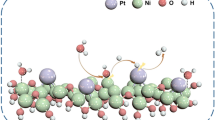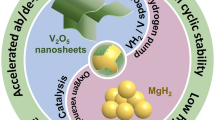Abstract
Transition metal oxides (TMOs) as low-cost hydrogenation catalysts exhibit high selectivity and durability. However, due to the lack of metal activation sites required for H2 dissociation, the harsh conditions such as high pressure (1–5 MPa H2) and high temperature (100–250°C) are usually needed to achieve H2 activation. Herein, we developed an amorphous nickel oxide nanosheets with an exceptionally low coordination number of the Ni-Ni shell, and this unique feature not only facilitated H2 activation but also preserved remarkable selectivity (∼99%) in the hydrogenation of vinyl group under mild conditions (room temperature (25°C) and low H2 pressure (100 kPa)).

摘要
过渡金属氧化物(TMOs)作为低成本的加氢催化剂, 具有良好的选择性和耐久性. 然而, 由于缺乏氢气解离所需的金属活化位点, 通常需要在高压(1–5 Mpa H2)和高温(100–250°C)等苛刻条件下才能实现氢的活化. 在此, 我们开发了一种具有极低的Ni−Ni配位数的非晶态氧化镍纳米片, 这种独特的特征不仅有利于H2的活化, 而且在室温(25°C)和室压(100 kPa H2)下, 乙烯基的加氢过程具有显著的活性与高选择性(∼99%).
Similar content being viewed by others
References
Song J, Huang ZF, Pan L, et al. Review on selective hydrogenation of nitroarene by catalytic, photocatalytic and electrocatalytic reactions. Appl Catal B-Environ, 2018, 227: 386–408
Zhang L, Zhou M, Wang A, et al. Selective hydrogenation over supported metal catalysts: From nanoparticles to single atoms. Chem Rev, 2020, 120: 683–733
Vilé G, Albani D, Almora-Barrios N, et al. Advances in the design of nanostructured catalysts for selective hydrogenation. ChemCatChem, 2016, 8: 21–33
Vilé G, Bridier B, Wichert J, et al. Ceria in hydrogenation catalysis: High selectivity in the conversion of alkynes to olefins. Angew Chem Int Ed, 2012, 51: 8620–8623
Corma A, Serna P. Chemoselective hydrogenation of nitro compounds with supported gold catalysts. Science, 2006, 313: 332–334
Du J, Huang Y, Huang Z, et al. Reversing the catalytic selectivity of single-atom Ru via support amorphization. JACS Au, 2022, 2: 1078–1083
Beier MJ, Andanson JM, Baiker A. Tuning the chemoselective hydrogenation of nitrostyrenes catalyzed by ionic liquid-supported platinum nanoparticles. ACS Catal, 2012, 2: 2587–2595
Fang C, Jiang X, Wang X, et al. PdRu nanocages as the switcher for the production of hydrogenation reaction toward 4-nitrostyrene. Appl Surf Sci, 2023, 615: 156138
Huang F, Deng Y, Chen Y, et al. Atomically dispersed Pd on nanodiamond/graphene hybrid for selective hydrogenation of acetylene. J Am Chem Soc, 2018, 140: 13142–13146
Zhang Z, Zhu Y, Asakura H, et al. Thermally stable single atom Pt/m-Al2O3 for selective hydrogenation and CO oxidation. Nat Commun, 2017, 8: 16100
Yan H, Cheng H, Yi H, et al. Single-atom Pd1/graphene catalyst achieved by atomic layer deposition: Remarkable performance in selective hydrogenation of 1,3-butadiene. J Am Chem Soc, 2015, 137: 10484–10487
Tian S, Wang B, Gong W, et al. Dual-atom Pt heterogeneous catalyst with excellent catalytic performances for the selective hydrogenation and epoxidation. Nat Commun, 2021, 12: 3181
Zhou P, Jiang L, Wang F, et al. High performance of a cobalt-nitrogen complex for the reduction and reductive coupling of nitro compounds into amines and their derivatives. Sci Adv, 2017, 3: e1601945
Tejeda-Serrano M, Cabrero-Antonino JR, Mainar-Ruiz V, et al. Synthesis of supported planar iron oxide nanoparticles and their chemo- and stereoselectivity for hydrogenation of alkynes. ACS Catal, 2017, 7: 3721–3729
Vilé G, Wrabetz S, Floryan L, et al. Stereo- and chemoselective character of supported CeO2 catalysts for continuous-flow three-phase alkyne hydrogenation. ChemCatChem, 2014, 6: 1928–1934
Westerhaus FA, Jagadeesh RV, Wienhöfer G, et al. Heterogenized cobalt oxide catalysts for nitroarene reduction by pyrolysis of molecularly defined complexes. Nat Chem, 2013, 5: 537–543
Bauer I, Knölker HJ. Iron catalysis in organic synthesis. Chem Rev, 2015, 115: 3170–3387
Albani D, Capdevila-Cortada M, Vilé G, et al. Semihydrogenation of acetylene on indium oxide: Proposed single-ensemble catalysis. Angew Chem Int Ed, 2017, 56: 10755–10760
Vilé G, Colussi S, Krumeich F, et al. Opposite face sensitivity of CeO2 in hydrogenation and oxidation catalysis. Angew Chem Int Ed, 2014, 53: 12069–12072
Jagadeesh RV, Surkus AE, Junge H, et al. Nanoscale Fe2O3-based catalysts for selective hydrogenation of nitroarenes to anilines. Science, 2013, 342: 1073–1076
Wu G, Zheng X, Cui P, et al. A general synthesis approach for amorphous noble metal nanosheets. Nat Commun, 2019, 10: 4855
Wang J, Han L, Huang B, et al. Amorphization activated ruthenium-tellurium nanorods for efficient water splitting. Nat Commun, 2019, 10: 5692
Chen X, Liu L, Yu PY, et al. Increasing solar absorption for photocatalysis with black hydrogenated titanium dioxide nanocrystals. Science, 2011, 331: 746–750
Sun R, Gao J, Wu G, et al. Amorphous metal oxide nanosheets featuring reversible structure transformations as sodium-ion battery anodes. Cell Rep Phys Sci, 2020, 1: 100118
Li R, Yang S, Zhang Y, et al. Short-range order in amorphous nickel oxide nanosheets enables selective and efficient electrochemical hydrogen peroxide production. Cell Rep Phys Sci, 2022, 3: 100788
Li R, Rao D, Zhou J, et al. Amorphization-induced surface electronic states modulation of cobaltous oxide nanosheets for lithium-sulfur batteries. Nat Commun, 2021, 12: 3102
Liu P, Huang Z, Yang S, et al. Support amorphization engineering regulates single-atom Ru as an electron pump for nitrogen photofixation. ACS Catal, 2022, 12: 8139–8146
Meng X, Yang Y, Chen L, et al. A control over hydrogenation selectivity of furfural via tuning exposed facet of Ni catalysts. ACS Catal, 2019, 9: 4226–4235
Mao J, Chen W, Sun W, et al. Rational control of the selectivity of a ruthenium catalyst for hydrogenation of 4-nitrostyrene by strain regulation. Angew Chem Int Ed, 2017, 56: 11971–11975
Lin Z, Du C, Yan B, et al. Two-dimensional amorphous NiO as a plasmonic photocatalyst for solar H2 evolution. Nat Commun, 2018, 9: 4036
Wang W, Liu Y, Xu C, et al. Synthesis of NiO nanorods by a novel simple precursor thermal decomposition approach. Chem Phys Lett, 2002, 362: 119–122
Zhou G, Wang DW, Li F, et al. Graphene-wrapped Fe3O4 anode material with improved reversible capacity and cyclic stability for lithium ion batteries. Chem Mater, 2010, 22: 5306–5313
Mansour AN. Characterization of NiO by XPS. Surf Sci Spectra, 1994, 3: 231–238
Zhao Y, Jia X, Chen G, et al. Ultrafine NiO nanosheets stabilized by TiO2 from monolayer NiTi-LDH precursors: An active water oxidation electrocatalyst. J Am Chem Soc, 2016, 138: 6517–6524
Wang H, Shi Y, Wang Z, et al. Selective hydrogenation of cinnamaldehyde to hydrocinnamaldehyde over Au-Pd/ultrathin SnNb2O6 nanosheets under visible light. J Catal, 2021, 396: 374–386
Shi Y, Wang H, Wang Z, et al. Pt decorated hierarchical Sb2WO6 microspheres as a surface functionalized photocatalyst for the visible-light-driven reduction of nitrobenzene to aniline. J Mater Chem A, 2020, 8: 18755–18766
Liang S, Wen L, Lin S, et al. Monolayer HNb3O8 for selective photocatalytic oxidation of benzylic alcohols with visible light response. Angew Chem Int Ed, 2014, 53: 2951–2955
Acknowledgements
This work was supported by the National Key R&D Program of China (2017YFA0700104 and 2018YFA0702001), the National Natural Science Foundation of China (21871238), the Fundamental Research Funds for the Central Universities (WK2060000016), Natural Science Foundation of Anhui Province (2208085J09) and USTC Tang Scholar. We thank the photoemission end stations MCD-A, MCD-B, BL10B in the National Synchrotron Radiation Laboratory (NSRL) and BL14W1 in Shanghai Synchrotron Radiation Facility (SSRF) for help in characterizations.
Author information
Authors and Affiliations
Contributions
Author contributions Hong X conceived the idea. Wu B carried out the sample synthesis, characterization and the organic reaction. Du J, Wu G and Zhang Q analyzed the data. Liu P, Zhang Q and Zheng X performed the XAS simulations. Han X carried out the TEM characterization. Zhang Q revised the paper. All authors contributed to the general discussion.
Corresponding author
Ethics declarations
Conflict of interest The authors declare that they have no conflict of interest.
Additional information
Bei Wu is currently a doctoral candidate at the University of Science and Technology of China (USTC). Her research interest focuses on the synthesis and characterization of amorphous materials and their applications in catalysis.
Junyi Du received his PhD in physical chemistry from the University of Chinese Academy of Sciences, and then he worked as a post-doctor fellow at USTC. His research focuses on the synthesis of high-entropy nanomaterials and their applications in electrocatalysis and organic reactions.
Geng Wu obtained his PhD degree in inorganic chemistry at USTC. His research interests focus on the synthesis and characterization of noble nanomaterials and their applications in energy storage and conversion.
Xun Hong received his PhD degree from USTC in 2010. He started working as a postdoctor at Tsinghua University and Nanyang Technological University in 2010 and 2012, respectively. In 2014, he joined USTC as a Principle Investigator. His research program aims at the synthesis and assembly of noble metals and alloy nanomaterials, and the synthesis and characterization of amorphous nanomaterials and supported single atom catalytic materials for electrocatalytic reactions.
Supplementary information Experimental details and supporting data are available in the online version of the paper.
Rights and permissions
About this article
Cite this article
Wu, B., Du, J., Wu, G. et al. Amorphous strategy to nickel oxide nanosheets for highly active and selective hydrogenation reaction. Sci. China Mater. 66, 3895–3900 (2023). https://doi.org/10.1007/s40843-023-2537-6
Received:
Accepted:
Published:
Issue Date:
DOI: https://doi.org/10.1007/s40843-023-2537-6




